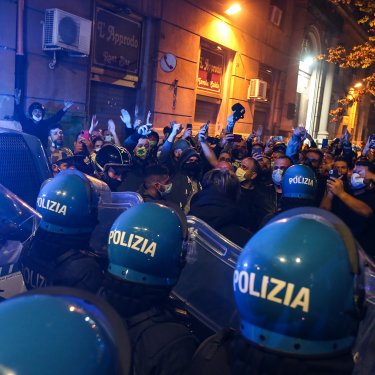Reporters attacked while covering protests against Covid-19 measures in Italy

After nine journalists were harassed and attacked while covering protests against Covid-19 lockdown measures in Italy in the past two weeks, Reporters Without Borders (RSF) urges the country’s politicians to firmly condemn such violence and calls on the authorities to provide the media with effective protection in the field.
The threats and acts of violence occurred during demonstrations in several cities in protest against the new measures that the authorities adopted in mid-October to combat a second wave of Covid-19 cases.
The victims included Valerio Lo Muzio, a video reporter for the newspaper La Repubblica, who was targeted in Bologna on 30 October by far-right protesters. They threatened and surrounded him, chanting “journalists, terrorists” and “shitty journalists,” and finally forced him to flee.
Both insults and bottles were hurled at journalists in Genoa on 26 and 28 October, to the point that police asked them to stop filming and leave the area in order to avoid any escalation in the violence.
There were several attacks against reporters in Palermo when a regional 11 pm - 5 am curfew was introduced there. After reporting from the scene of a peaceful protest by a crowd of restaurant owners on the evening of 24 October, Rai Sicilia TV reporter Raffaella Cosentino and her cameraman were called “terrorists” and were threatened by three men without face masks who were linked to the far-right group Forza Nuova. Cosentino and her colleague ended up having to leave.
Two other protests were held almost simultaneously four days later. The first, which mainly involved Forza Nuova members and pandemic deniers, led to clashes with the police. Two journalists working for the Rai 2 news programme TG2, reporter Vincenzo Frenda and cameraman Ninni Farina, were threatened with being beaten by men who stole their microphone and microphone boom.
In the second demonstration, which was organized by civil society groups in protest against the crisis’s impact on workers and which also degenerated into a clash with police, Michele Schillaci, an agency cameraman working for Mediaset, sustained an ear injury when a firecracker exploded next to his head.
Finally, Sky Tg24 reporter Paolo Fratter and cameramen Vincenzo Triente and Fabio Giulianelli were pushed and hit by protesters during a live broadcast from the scene of clashes in Naples on 23 October between police and protesters against the curfew introduced in the Campania region. Fratter was slammed against the hood of a car while Giulianelli’s leg was injured when hit by one of the stones that were thrown.
“During a public health, economic and social crisis of this scale, journalists should be more than ever able to cover the situation,” said Pavol Szalai, the head of RSF’s European Union and Balkans desk. “But the media are the targets of systematic violence that is intensifying by the day. We call on all Italian politicians to firmly condemn these attacks and we urge the police to provide journalists in the field with real, constant protection.”
Italy is not the only European country to see this kind of violence against the media. In Austria, journalists were threatened and attacked in Vienna on 26 October, while police looked on without intervening. In Germany, state media and journalists, including Tagesspiegel reporter Julius Geiler, were threatened by “corona-sceptic” protesters in Berlin on 25 October. In a sign of the worsening climate for the media in the Netherlands, state TV channel NOS was forced to remove its logo from its vehicles on 15 October after repeated threats and verbal attacks on identifiable employees.
Italy is ranked 41st out of 180 countries in RSF's 2020 World Press Freedom Index, Austria is ranked 18th, Germany is ranked 11th and the Netherlands is ranked 5th.



